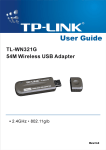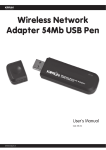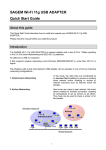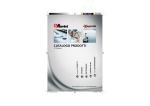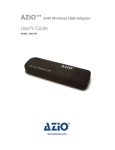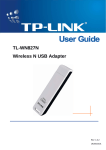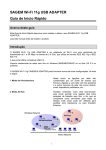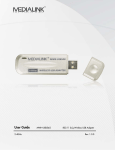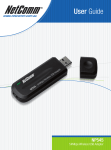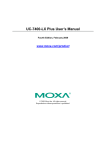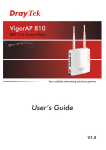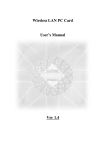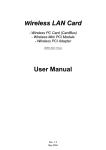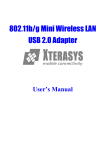Download WIRELESS USB 2.0 USER MANUAL
Transcript
WIRELESS USB 2.0 54Mbps Wireless USB Adapter USER MANUAL www.hamletcom.com Dear Customer, thanks for choosing an Hamlet product. Please carefully follow the instructions for its use and maintenance and, once this item has run its life span, we kindly ask You to dispose of it in an environmentally friendly way, by putting it in the separate bins for electrical/electronic waste, or to bring it back to your retailer who will collect it for free. We inform You this product is manufactured with materials and components in compliance with ROHS directives: 2002/95/CE, 2002/96/CE, 2003/108/CE; with RAEE Directives: 2003/96/CE, Italian Legislative Decree 2005/151 and below EEC Directives: ETSI EN 300 328 V1.4.1: 2003, ETSI EN 301 489-17 V1.2.1: 2002, EN 61000-3-2: 2000, EN 61000-3-3: 1995 + A1: 2001, EN 60950-1: 2001, EN 50392: 2004. I FCC STATEMENT This equipment has been tested and found to comply with the limits for a Class B digital device, pursuant to part 15 of the FCC Rules. These limits are designed to provide reasonable protection against harmful interference in a residential installation. This equipment generates, uses and can radiate radio frequency energy and, if not installed and used in accordance with the instructions, may cause harmful interference to radio communications. However, there is no guarantee that interference will not occur in a particular installation. If this equipment does cause harmful interference to radio or television reception, which can be determined by turning the equipment off and on, the user is encouraged to try to correct the interference by one or more of the following measures: • • • • Reorient or relocate the receiving antenna. Increase the separation between the equipment and receiver. Connect the equipment into an outlet on a circuit different from that to which the receiver is connected. Consult the dealer or an experienced radio/ TV technician for help. This device complies with part 15 of the FCC Rules. Operation is subject to the following two conditions: 1) 2) This device may not cause harmful interference. This device must accept any interference received, including interference that may cause undesired operation. FCC RF Radiation Exposure Statement This device has been tested for compliance with FCC RF Exposure (SAR) limits in the typical laptop computer configuration and this device can be used in desktop or laptop computers with side mounted PCMCIA slots. This device cannot be used with handheld PDAs (personal digital assistants). This device and its antenna must not be co-located or operated in conjunction with any other antenna or transmitter. CE Mark Warning This is a class B product. In a domestic environment, this product may cause radio interference, in which case the user may be required to take adequate measures. II CONTENTS Chapter 1 Introduction 1 1.1 Product Overview ...................................................................................................... 1 1.2 Package Contents...................................................................................................... 1 1.3 Main Features............................................................................................................ 1 1.4 LED Status ................................................................................................................ 1 Chapter 2 2.1 2.2 2 Software Installation................................................................................................... 2 2.1.1 Overview ..................................................................................................................................2 2.1.2 Software Installation for Windows XP ....................................................................................2 Uninstall Software ...................................................................................................... 5 2.2.1 Uninstall the driver software from your PC ............................................................................5 2.2.2 Uninstall the utility software from your PC.............................................................................5 Chapter 3 3.1 Installation Guide Configuration 6 Profile ........................................................................................................................ 6 3.1.1 Add or Edit a Configuration Profile.........................................................................................7 3.2 Link Status ............................................................................................................... 10 3.3 Site Survey .............................................................................................................. 11 3.4 Statistics .................................................................................................................. 11 3.5 Advanced................................................................................................................. 12 3.6 About ....................................................................................................................... 12 3.7 An example for application....................................................................................... 13 Glossary 14 Specifications 16 III HNWU254G 54Mbit Wireless USB Adapter User Manual Chapter 1 Introduction 1.1 Product Overview The HNWU254G 54Mbit Wireless USB Adapter is a USB 2.0 pen-size wireless adapter supporting IEEE 802.11b/g 2.4GHz radio operation. It provides high-speed wireless connection with data rate up to 54Mbps. Additionally, wireless roaming allows the user to move among different AP without losing the current connection. The adapter provides excellent security features includingTKIP, AES, WPA, and up to 128 bit WEP encryption security make the network almost impenetrable. Featuring high performance transmission rates, simple installation and adaptability, as well as strong security the HNWU254G 54M Wireless USB Adapter is the perfect solution for small office and home needs. 1.2 Package Contents One HNWU254G 54M Wireless USB Adapter One Resource CD, including: Drivers, Utility and User Guide 1.3 Main Features Complies with IEEE 802.11g, IEEE 802.11b standards Supports WPA data security, IEEE 802.1x authentication, TKIP/AES encryption, 64/128-bit WEP encryption Supports 54/48/36/24/18/12/9/6Mbps or 11/5.5/2/1Mbps wireless LAN data transfer rates Provides USB interface Supports Ad-Hoc and Infrastructure modes Supports roaming between access points when configured in Infrastructure mode Eases configuration and provides monitoring information Internal Antenna Supports Windows 98SE, Me, 2000, XP, Vista 1.4 LED Status The LED on the top of this card indicates Link/Act status. It blinks at green light when sending and receiving data. www.hamletcom.com 1 HNWU254G 54Mbit Wireless USB Adapter User Manual Chapter 2 Installation Guide 2.1 Software Installation 2.1.1 Overview The Adapter’s Setup Wizard will guide you through the installation procedure for Windows 98SE, Me, 2000, XP and Vista. The Setup Wizard will guide you install the Utility and drivers. If you install the hardware before the software, you will be prompted “Found New Hardware Wizard”, click the Cancel button, and run the Setup Wizard program on the CD-ROM. The Setup steps for Windows 98SE, Me, 2000 and XP are very similar. The following setup steps are for windows XP. 2.1.2 Software Installation for Windows XP 1. Insert the Resource CD into your CD-ROM drive, click the Start button and choose Run. In the field that appears, enter F:\XXX\Setup.exe (if “F” is the letter of your CD-ROM drive; XXX presents the setup program path, which is labeled on the Resource CD), Figure 2-1should then appear. 2. You can click the Cancel button to end the installation on the Preparing Setup screen, Figure 2-1. Otherwise, the Setup Wizard will display a screen similar to that shown in Figure 2-2 after a moment. Figure 2-1 Preparing Setup 3. To continue, click the Next button on the screen, Figure 2-2. Click the Cancel button to end the Installation. www.hamletcom.com 2 HNWU254G 54Mbit Wireless USB Adapter User Manual Figure 2-2 Start Setup 4. Click Browse to change the destination location for the software in Figure 2-3. Click Next to continue the Installation. Click Back to return to the previous page, or click Cancel to exit the Installation. Figure 2-3 Choose Destination Location www.hamletcom.com 3 HNWU254G 54Mbit Wireless USB Adapter 5. User Manual While files are copying, you will see a warning box shown in Figure 2-4. Please select Continue to continue installation. Our drivers have been tested thoroughly, and are able to work with the operating system. Figure 2-4 Windows XP Warning Box 6. After the files have been successfully copied, the screen in Figure 2-5 will appear. Click the Finish button to exit the installation wizard. Figure 2-5 Finish 7. After installing the software, Please plug the adapter into your PC. If you have plugged it into you PC already, please un-plug it and plug it back in. The OS will automatically detect www.hamletcom.com 4 HNWU254G 54Mbit Wireless USB Adapter User Manual the adapter and automatically setup the driver for the adapter. If it does not, please follow the setup steps to finish the driver installation. After installing the driver successfully, you should see an icon, or , appear in your system tray. 2.2 Uninstall Software 2.2.1 Uninstall the driver software from your PC 1. On the Windows taskbar, click the Start button, point to Settings, and then click Control Panel. 2. Double-click the System icon and click on the Hardware tab in the System window. 3. Click on the Device Manager button, double-click Network Adapters, and then right-click HNWU254G Wireless Adapter (Figure 2-6). 4. Click Uninstall..., the system will uninstall the driver software of the adapter from your PC. Figure 2-6 Device Manager window 2.2.2 Uninstall the utility software from your PC 1. On the Windows taskbar, click the Start button, point to Settings, and then click Control Panel. 2. Double-click the Add/Remove Programs icon, find the HNWU254G Wireless Client Utility program from the installed program list, highlight it and click the Remove button. 3. Following the Install Shield Wizard will uninstall the utility software from your PC. www.hamletcom.com 5 HNWU254G 54Mbit Wireless USB Adapter User Manual Chapter 3 Configuration HAMLET HNWU254G Wireless USB Adapter can be configured by its utility. This section describes how to configure your Wireless USB Adapter for wireless connectivity on your Wireless Local Area Network (WLAN) and use the data security encryption features. After the Adapter's driver and utility has been installed, the adapter’s tray icon, or , will appear in your system tray. It means the utility is running on your system. If the utility does not run, you can run the utility by clicking: Start > Program > HAMLET > HNWU254G > HNWU254G Wireless Client Utility. If the icon still does not appear, the driver or utility may be installed incorrectly or the adapter is unplugged, please try again. Icon (with green bars) means the connection has been established. Icon (with grey bars) means there is no connection. Double-click the icon and the configuration screen of the utility will appear. You can also run the utility by clicking: Start > Program > HAMLET > HNWU254G > HNWU254G Wireless Client Utility. The utility provides a complete and easy to use set of tools to: Display current status information Edit and add configured profiles Display current diagnostics information The section below introduces these above capabilities. Note: If your OS is Windows XP, you can use Windows XP to configure the wireless network settings (To use this function, you must upgrade the OS with Service Pack 1). If you want to use Windows XP to configure wireless network settings, just exit the utility. Right-click the icon 3.1 at the bottom of the screen, and click Exit to exit the utility. Profile Click the Profile tab of the utility and the Profile screen will appear, Figure 3-1. The Profile screen provides tools to: Add a profile Delete a profile Edit a profile Activate a profile www.hamletcom.com 6 HNWU254G 54Mbit Wireless USB Adapter User Manual Figure 3-1 Profile Tab To create a new profile, click the Add button on the Profile tab, the Profile configuration screen will appear as shown in Figure 3-2. To edit a profile, highlight the desired profile name on Profile Name list, and click the Edit button, the Profile configuration screen will appear shown in Figure 3-2. To delete a profile, highlight the desired profile name on Profile Name list, and click the Delete button. To switch to another profile, highlight the desired profile name on Profile Name list, and click the Activate button. Note: Do not forget to click the Apply button when you create a new profile for connection. 3.1.1 Add or Edit a Configuration Profile To add a new configuration profile, click Add button on the Profile Management tab. To modify a configuration profile, select the configuration from the Profile list and click Edit. The Profile Management dialog box will display a screen similar to that shown in Figure 3-2. 1. Edit the Configuration tab Profile Name – Identifies the configuration profile. This name must be unique. Profile names are not case-sensitive. www.hamletcom.com 7 HNWU254G 54Mbit Wireless USB Adapter User Manual SSID – The IEEE 802.11 wireless network name. This field has a maximum limit of 32 characters. PSM(Power Save Mode) • CAM(Constantly Awake Mode) – Continuous Access Mode. • PSM(Power Saving Mode) – Power Saving mode. Network Type – Displays the wireless mode, either Ad-hoc or Infrastructure mode. Preamble – Specifies the preamble setting in 802.11b. The default setting is Auto Switch (access point mode), which allows both short and long headers in the 802.11b frames. The adapter can only use short radio headers if the access point supports and uses them. RTS Threshold – Default is 2312. Fragment Threshold – Default is 2312. Ad-hoc mode – Displays the wireless mode, either Only 802.11B or 802.11B/G mode. Channel – Shows the current channel in use. This field determines which operating frequency will be used. Figure 3-2 Add Profile - Configuration www.hamletcom.com 8 HNWU254G 54Mbit Wireless USB Adapter 2. User Manual Edit the Authentication and Security tab Figure 3-3 Add Profile – Authentication and Security Authentication Type – Three options, Open System, Shared-Key System or LEAP. 802.1x Setting – It enables when Authentication Type is setting to WPA. Encryption – Displays which encryption type that the driver is using. When you select Open System, Shared-Key System as Network Authentication, there are two options: WEP and Disabled. If you select WPA-PSK as Network Authentication, there are TKIP and AES options instead of WEP and Disabled. Wep Key – Key #1, Key #2, Key #3, Key #4, the Key groups. You can enter 10 hexadecimal digits (any combination of 0-9, a-f, A-F) or 5 ASCII characters for 64-bit (also called 40bits) encryption. You can enter 26 hexadecimal digits (any combination of 0-9, a-f, A-F) or 13 ASCII characters for 128-bit (also called 104bits) encryption. www.hamletcom.com 9 HNWU254G 54Mbit Wireless USB Adapter 3.2 User Manual Link Status The Link Status tab displays the adapter's current status. Figure 3-4 Link Status The following table describes the items found on the Network Status screen. Status - Shows whether the station is connected to the wireless network, if not connected, display RF is closed; if connected, display AP name and BSSID. Extra Info - Shows link status. Channel - Shows the current channel in use. Link Speed - Shows the current max Transfer rate, unit is Mbit/sec. Throughput - Displays Tx and Rx rate, unit is Kbits/sec. Link Quality - Shows the quality of the signal. Signal Strength - Shows the strength of the signal. Noise Level - Shows the noise level of the signal. www.hamletcom.com 10 HNWU254G 54Mbit Wireless USB Adapter 3.3 User Manual Site Survey Click the Site Survey tab of the Utility and the Site Survey screen will appear, Figure 3-5. On the Site Survey screen you can scan the Available Infrastructure and Ad Hoc Networks. Figure 3-5 Site Survey tab Click the Rescan button to refresh the list at any time. Highlight an SSID and click the Connect button to connect to an available network. 3.4 Statistics The Statistics tab shows receiving and transmitting statistical information for the following receive and transmit diagnostics for frames received by or transmitted to the wireless network adapter. Click the Reset Counter button to reset the count of the statistics information. Figure 3-6 Statistics tab www.hamletcom.com 11 HNWU254G 54Mbit Wireless USB Adapter 3.5 User Manual Advanced On this Screen, you can configure the WEP key or view the configured WEP key. Figure 3-7 Advanced Wireless mode - Displays the wireless mode, either 802.11B/G mix or 802.11B only. B/G Protection - There are three options: either Auto or Enable, or Close. TxRate - Shows the current Transfer rate. TxBURST - It can translate more data when it enable. Fast Roaming at - Roaming will disable when Transmit Power is below some dBm. Turn off RF - The wireless radio of this adapter can be enabled or disabled. You can turn the wireless radio off by selecting the check-box. Apply - Click the Apply button to save the current setting. 3.6 About This screen displays some information about this adapter, including Driver Date, Driver Version, Utility Date, Utility Version, MAC Address, IP Address, SubMask, Power Save mode and Preamble. Utility Version – The version of this utility. Utility Date – The creation date of this utility. Driver Version – The version of the wireless network adapter driver. Driver Date – The creation date of the wireless network adapter driver. EEPROM Version – The version of this EEPROM. www.hamletcom.com 12 HNWU254G 54Mbit Wireless USB Adapter Firmware Version – The version of this Firmware IP Address – The IP address of the wireless network. MAC Address – The MAC address of the wireless network adapter. Sub Mask – The subnet mask of the wireless network. Default Gateway – The default gateway of the wireless network. User Manual Figure 3-8 About 3.7 An example for application Suppose you have an installed and using AP, the SSID is HAMLET and it adopts 64-bit encryption with the key 0123456789. To establish a connection with this AP, you should follow these steps below: 1. Launch HNWU254G WIRELESS UTILITY. 2. Click the Profile tab of the utility and click the New button on the screen that appears. 3. The Profile configuration screen will appear, please enter Test for the Profile Name, HAMLET for the SSID, select Infrastructure for the Network Mode, select WEP for the Data Encryption and enter 0123456789 for Network key. 4. Click OK to save this profile. 5. Click Apply on the Profile screen. The utility will establish a connection with this AP by configured profile. www.hamletcom.com 13 HNWU254G 54Mbit Wireless USB Adapter User Manual Glossary 802.11b - The 802.11b standard specifies a wireless networking at 11 Mbps using direct-sequence spread-spectrum (DSSS) technology and operating in the unlicensed radio spectrum at 2.4GHz, and WEP encryption for security. 802.11b networks are also referred to as Wi-Fi networks. 802.11g - specification for wireless networking at 54 Mbps using direct-sequence spread-spectrum (DSSS) technology, using OFDM modulation and operating in the unlicensed radio spectrum at 2.4GHz, and backward compatibility with IEEE 802.11b devices, and WEP encryption for security. Ad-hoc Network - An ad-hoc network is a group of computers, each with a wireless adapter, connected as an independent 802.11 wireless LAN. Ad-hoc wireless computers operate on a peer-to-peer basis, communicating directly with each other without the use of an access point. Ad-hoc mode is also referred to as an Independent Basic Service Set (IBSS) or as peer-to-peer mode, and is useful at a departmental scale or SOHO operation. DSSS (Direct-Sequence Spread Spectrum) - DSSS generates a redundant bit pattern for all data transmitted. This bit pattern is called a chip (or chipping code). Even if one or more bits in the chip are damaged during transmission, statistical techniques embedded in the receiver can recover the original data without the need for retransmission. To an unintended receiver, DSSS appears as low power wideband noise and is rejected (ignored) by most narrowband receivers. However, to an intended receiver (i.e. another wireless LAN endpoint), the DSSS signal is recognized as the only valid signal, and interference is inherently rejected (ignored). FHSS (Frequency Hopping Spread Spectrum) - FHSS continuously changes (hops) the carrier frequency of a conventional carrier several times per second according to a pseudo-random set of channels. Because a fixed frequency is not used, and only the transmitter and receiver know the hop patterns, interception of FHSS is extremely difficult. Infrastructure Network - An infrastructure network is a group of computers or other devices, each with a wireless adapter, connected as an 802.11 wireless LAN. In infrastructure mode, the wireless devices communicate with each other and to a wired network by first going through an access point. An infrastructure wireless network connected to a wired network is referred to as a Basic Service Set (BSS). A set of two or more BSS in a single network is referred to as an Extended Service Set (ESS). Infrastructure mode is useful at a corporation scale, or when it is necessary to connect the wired and wireless networks. Spread Spectrum - Spread Spectrum technology is a wideband radio frequency technique developed by the military for use in reliable, secure, mission-critical communications systems. It is designed to trade off bandwidth efficiency for reliability, integrity, and security. In other words, more bandwidth is consumed than in the case of narrowband transmission, but the trade off produces a signal that is, in effect, louder and thus easier to detect, provided that the receiver knows the parameters of the spread-spectrum signal being broadcast. If a receiver is not tuned to the right frequency, a spread-spectrum signal looks like background noise. There are two main www.hamletcom.com 14 HNWU254G 54Mbit Wireless USB Adapter User Manual alternatives, Direct Sequence Spread Spectrum (DSSS) and Frequency Hopping Spread Spectrum (FHSS). SSID - A Service Set Identification is a thirty-two character (maximum) alphanumeric key identifying a wireless local area network. For the wireless devices in a network to communicate with each other, all devices must be configured with the same SSID. This is typically the configuration parameter for a wireless PC card. It corresponds to the ESSID in the wireless Access Point and to the wireless network name. WEP (Wired Equivalent Privacy) - A data privacy mechanism based on a 64-bit or 128-bit or 152-bit shared key algorithm, as described in the IEEE 802.11 standard. Wi-Fi - A trade name for the 802.11b wireless networking standard, given by the Wireless Ethernet Compatibility Alliance (WECA, see http://www.wi-fi.net), an industry standards group promoting interoperability among 802.11b devices. WLAN (Wireless Local Area Network) - A group of computers and associated devices communicate with each other wirelessly, which network serving users are limited in a local area. WPA (Wi-Fi Protected Access) - A wireless security protocol use TKIP (Temporal Key Integrity Protocol) encryption, which can be used in conjunction with a RADIUS server. www.hamletcom.com 15 HNWU254G 54Mbit Wireless USB Adapter User Manual Specifications General Interface A-type USB 2.0 Connector Standards IEEE 802.1b; IEEE 802.1g Operating System Transmission Distance Safety & Emission Windows 98SE, ME, 2000, XP, Vista In door up to 100m, out door up to 300m (It is limited to the environment). FCC, CE Frequency 2.4 ~ 2.4835 GHz Sensitivity 54M -70dBm 11M -83dBm Spread Spectrum Direct Sequence Spread Spectrum (DSSS) Wireless Radio Data Rate Modulation Media Access Protocol Transmit Power Data Security 54/48/36/24/18/12/9/6 Mbps 11g OFDM 11/5.5/2/1 Mbps 11b DSSS, (Auto Rate Sensing) 11g OFDM; 11b DSSS , FHSS with DBPSK/DQPSK/CCK CSMA/CA with ACK 14dBm (Typical) WPA, 64/128 bit WEP, TKIP/AES, IEEE 802.1X authentication Physical Environmental Working Temperature 0 °C ~ 40 °C (32 °F ~ 104 °F) Storage Temperature -40 °C ~ 70 °C (-40 °F ~ 158 °F) Humidity 10% ~ 90% RH, Non-condensing Dimensions (WDH) www.hamletcom.com 3.41.00.4 inch (87.0 mm26.0 mm11.2 mm) 16




















